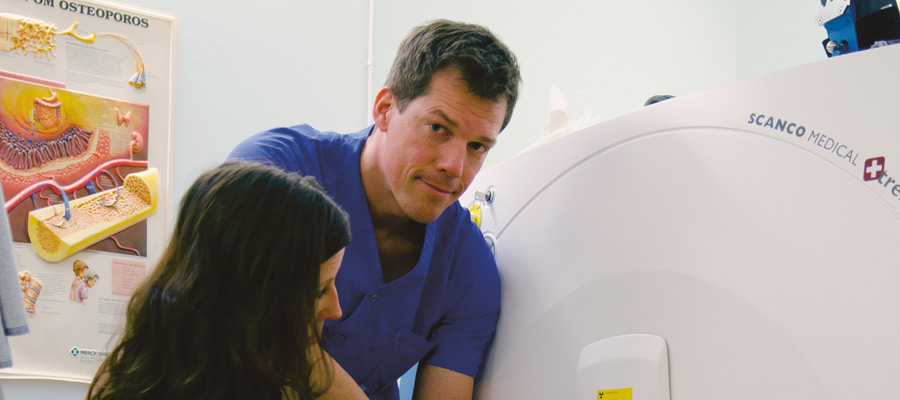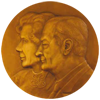
Mattias Lorentzon, a professor in the Department of internal medicine and clinical nutrition, Sahlgrenska Academy, studying
bone microstructure among various groups to determine the impact of adipose tissue can have on the development of osteoporosis. NOTE – This article is machine translated from Swedish.
If you are interested in how fat tissue and bone work together, what could be better to study than people who either gain weight greatly or going down quickly. There are at least two of the groups of patients Mattias Lorentzon, a professor in the Department of internal medicine and clinical nutrition, Sahlgrenska Academy, engaged in. Obesity is an increasingly growing problem, as well as osteoporosis. Is there possibly a connection?
Mattias Lorentzon want to find out what happens when the fat content increases or decreases in the body. Therefore, studying he right now people who undergo fat man operation against his being overweight, also known as gastric by-pass. These patients come tumbling down in weight. They lose large amounts of fat but also muscle and bone mass. Another group he plans to study are those who instead greatly increases weight in a short period of time, and it is anorexic during intensive treatment. At six months, they can increase 20% in fettmasssa.
Osteoporosis is increasing throughout the world, and it has been with the ever-increasing life expectancy to do.
– We are evolutionarily designed to be just so old that we can take care of our children until they can make the most of themselves, not to maintain our capabilities much later than that, “said Mattias Lorentzon, a professor in the Department of internal medicine and clinical nutrition, Sahlgrenska Academy.
Despite the fact that it is becoming increasingly common and is already a major clinical problem – it’s only stroke causing more hospital days – is osteoporosis a neglected diagnosis, according to Mattias Lorentzon.
– Often starts with a wrist fracture after the age of 60. After 70 a kot-or överarmsfraktur, and after 80 a hip fracture. Both kot and hip fractures can have fatal consequences, with significantly increased mortality and reduced mobility.
Mattias Lorentzon and his research group is now in the final stages of collecting data from 78-80-year-olds in Gothenburg. Of the 3000 that will be included in the study before it is interrupted is now data from 2916 people collected.
“We have asked all at that age in Large Gothenburg. We meet characters one or more times and we collect everything we can. We measure them from head to toe, they must fill out surveys, we take a lot of blood tests, and then we follow what happens to their health in different registers, and can see if, for example, they have fractures.
Interaction of adipose tissue and bone
The study was begun three years ago and Mattias Lorentzon has gradually been looking at the results. Exciting data from analyses of the 1000 first persons strengthens his hypothesis about interactions between the adipose tissue and bone. He has seen that while abdominal obesity is a risk factor for cardiovascular disease, does not seem the sort of obesity be related to effects on the skeleton. On the other hand, there seems to be a local impact of fat in the arms and legs. In a
Group of older women with a lot of subcutaneous fat in the limbs, he discovered that the cortical bone, which is what dominates in long long bone and hip, was softer than in obese people. This was done with a method known as indentation, which with a PIN that sticks into the bone to determine how hard it is. Tomografidata from the study confirms and extends the results – even the structure of kortikalt bone is different in those with very fat.
– The more fat, and, above all, locally, subcutaneous fat, the more pores was present in the cortical bone and the softer it was. Our hypothesis is that fat secretes cytokines, such as adiponektin and leptin, which seems to hang together with osteoporosis, which provides a local effect on bone.
In particular, older women are at high risk for osteoporosis. In connection with menopause, when estrogen levels drop drastically, broken leg down twice as fast as before, to a few years later to go over in a calmer then the rate.
– Older women will be according to the recommendations offered risk evaluation and prevention of osteoporosis, but it is not happening. In addition, no more than 14 percent of the women who have already had a fracture a secondary prevention. On the other hand, we are examining at Sahlgrenska all over the fifty years with fracture routinely.
Despite the fact that the diagnosis be treated a bit neglected right now, there is hope for the future. In research has been great the past few years, according to Mattias Lorentzon.
– WHO decided in 1994 how the diagnosis would look like, and since then, we’ve learned a lot about biology; If the bone is broken down and built up, we have identified new genes that control bone turnover, found markers of osteoporosis, developed antibodies against metabolizing proteins that are now being tested in clinical trials, and within a few years, we have
probably a drug that builds brand new legs.
With the help of its appropriations authorised use Mattias Lorentzon now new and better methods in his research to study the bones.
“We can see the bone microstructure with amazing resolution and get much more information. With high resolution computed tomography, so-called Xtrem-CT, built 110 CT-cut together into a three-dimensional image and from there get out almost as much information from a biopsy. I hope that these will become part of everyday clinical practice
eventually. With a traditional DEXA, therefore the appliance for 20 years been used for
diagnosis of osteoporosis, do you get a two dimensional image of the bone and a rough estimate of the mineral content. It works pretty good but does not provide any information. One problem is that big ben is looking tighter than they necessarily.
Negative consequences of obesity surgery
The large group that is now undergoing obesity surgery is a group to keep extra watch over according to Mattias Lorentzon. Gastric by-pass certainly protects against cardiovascular disease but it has also been shown to have negative effects, including fractures.
– Now we massopererar but what happens when these people are 80? Some get severe bone influence. They can, for example, not to mention vitamin D and calcium in sufficient quantities which have adverse effects on the skeleton.
Through his research hoping Mattias Lorentzon get better grip on the bone microstructure in osteoporosis. That way it will be easier to predict fracture risk and this can be added to the Clinical Diagnostics. To use the Xtrem-CT with 110 cut will not be up-to-date in the clinic but as long as you know what to look for perhaps a simplified method with a few cuts can suffice, think Mattias Lorentzon. To be better able to predict fracture risk will be very useful both for those who fetmaopererats but also for everyone else, from the beginning of normal weight, with osteoporosis. This allows preventive measures are taken in time.
